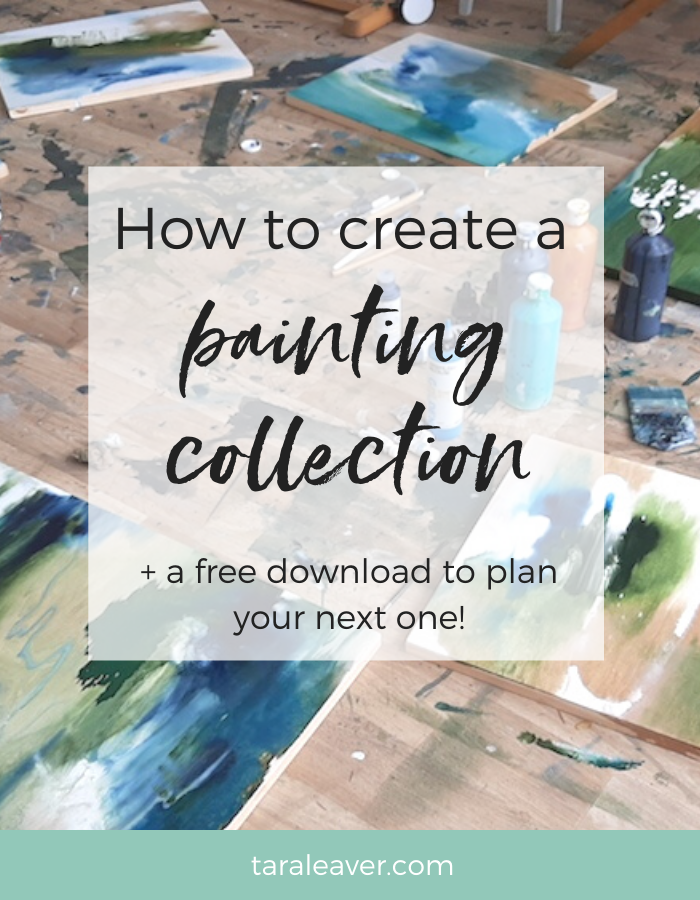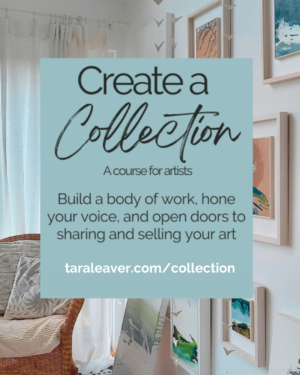
Have you been wanting to create a painting collection?
Are you ready to move from one-at-a-time painting to creating in collections or series?
Or have you already started working in collections and are running up against some blocks?
If you’ve never worked in this way you might have some questions about how best to go about it. Or maybe you want to streamline your process.
Whatever your reasons, hooray, because that’s what this post is all about!
I used to make paintings one at a time {I wrote about it here}, and after a while I found it was really holding me back.
I’d literally end up painting myself into a corner and get tight and frustrated and stuck. If a painting wasn’t working, I often ended up with ‘nowhere to go’.
At the simplest level, starting to work on more than one painting at a time was a total game changer, simply because it gave me more than one thing to work on!
So today, I’m going to share what I’ve learned about how to create a painting collection {or series}, with tips and things to think about, and a free download to plan your next {or first!} collection!
So let’s break this down.
Reasons you might like to create a painting collection
- More spontaneity and freedom
- No more getting stuck, so you can stay in the flow longer
- Natural cohesiveness to the work
- The paintings inform each other
- When the energy drops with one, there are more to play with
- Builds momentum to finish more paintings
- Allows for switching pace according to your energy
- Less paint wastage
- Reduce or bypass blank canvas syndrome
- It helps you go deep into a subject or theme
Collections don’t suit everyone’s way of working, but if you’re finding yourself getting stuck doing one or two at a time, they are a great way to work.
How to prepare for creating collections
If you haven’t worked this way before, there are a few things to consider.
This is going to take up more space
If you typically work relatively large, or don’t have a huge amount of space, you may need to recalibrate both mentally and practically to accommodate this different approach.
You can scale down to have more to work on at any one time {potentially less outlay on materials!}, or you can decide to stick to a lower number of pieces to stay closer to your usual or preferred scale.
Ideally you want to be able to see all the pieces at once for maximum benefits, but of course there are always workarounds.
For example, you could start working on four at a time and have each set of four be your collection.
Or you can work in batches on a larger number of works, and rotate the ones you can see at any one time.
If you typically work at an easel, can you move to the wall using hooks, nails, or picture ledges?
If you typically work flat at a table, can you increase your table space {maybe do a clear up 😉 }, or work on the floor?
If weather and location permit, can you work outside?
There are lots of ways to adapt your current practice with a bit of creative thinking, which is, after all, something we’re already good at. 😉
Acknowledge the mindset shift
If you’re used to working on one or two paintings at a time, it’s normal to need a little adjustment to ‘getting’ how it works to be in process with many paintings at once.
Most likely you’ll find it liberating, but don’t worry if it takes a minute to get used to.
Making art is like an iceberg; the bit we see is just a tiny percentage.
Most of what’s hidden is mindset, which is worth remembering not just for this topic but for anything art related.
Just a little bit of tangential wisdom for you there. 😉
The actual process
While I sometimes add to collections later, and don’t always make the entire collection at once, it is easiest to start out with everything you need.
1. Spend some time thinking about your concept or topic.
If you’re used to ‘one at a time’ painting, this is an opportunity to really dig deep into a subject that fascinates you.
It’s likely you already have a good idea of what interests you, and have been painting that subject a while already.
This is an opportunity to explore it in much more depth.
I spend weeks, sometimes months or even years, percolating particular ideas that come to me.
I typically have the name and vision of the collection before I have a solid sense of how I’m going to approach it, but spending time absorbing inspiration, making notes, and imagining how I want to say what I want to say, is all an essential part of the process.
Gather your inspiration as you prepare, taking photos, making sketches, collecting postcards or magazine images – whatever visual prompts and springboards you need to help you make the work.
2. Decide on the number of pieces you want to make, taking into account the space you have available.
At the size I like to work, which is typically from around 8 x 10 in to around 20 x 24 in, I can comfortably work on about fifteen or so paintings at a time and still be able to see them all.
A collection can be any number of works you choose though! There are no rules about that, only what works for you.
3. Make any necessary materials purchases – paints, brushes, mediums, and of course your substrates.
I order wood panels from Jacksons {aff. link} in the UK, buying several sizes per collection. I also make sure I have enough paint, airbrush medium, inks, and brushes of the size and kind I like.
4. If necessary, tidy up where you make your art so you have maximum space and minimum visual distractions.
I usually stick a list of ideas, key words and phrases, the title of my collection, and any painting titles I may want to use, to the wall of the studio. {You can use this printable collection planner if it’s helpful!}
5. Consider setting a deadline
This is completely optional.
If you’re creating work that’s going to a gallery show, you may have a built in deadline.
Otherwise, you can either set an arbitrary deadline, perhaps adding a layer of accountability by announcing the release date of your collection on social media, or simply work on your collection until you feel it’s complete.
Some people find that no deadline sounds freeing but can end up meaning paintings don’t get finished, or the energy fizzles out.
Others are motivated more from the inside, so don’t need a deadline.
You can even make one up, not tell anyone, and move it if necessary!
Other things to consider
- Is the work going to need framing? Or would you prefer to work on paper or canvases which can be sold without frames?
- Hang or arrange the paintings together both during the process and at the end, to make sure they are all complete and in harmony.
- If you’re going to be selling the work, start talking about it and sharing peeks as you go through the process of creating it, to pique people’s interest and bring them along on the journey with you. If you have a mailing list {highly recommended if you are going to be selling the work}, you can invite people to sign up for priority access to the work when you release it.
Working in collections has been a game changer for me.
While I still get stuck on paintings, it no longer holds me back; I can simply work on others and gather new ideas to take that stuck painting forward.
I think of each collection as a chapter in a book about coastal living. That way I can explore lots of different aspects of living by the sea without being tied to repeating one thing forever.
And while each collection has its own personality, and some look quite different from each other, they work together as a ‘book’ because a} I made them, and b} working this way creates unity effortlessly.
If you’d like a free printable copy of my Painting Collection Planner, you can download it here! {It comes from my flexible planner for artists, which you can find here.}
Got questions about creating collections? Share them in the comments below and I’ll do my best to help you!
 If you think working in multiples might be for you but are not sure where to begin, check out my course, Create a Collection.
If you think working in multiples might be for you but are not sure where to begin, check out my course, Create a Collection.
We’ll spend five weeks together going through the entire process of making a cohesive body of work, from initial idea and preparations, to ways to sell it once its complete, navigating challenges and decision making along the way.
There’s a small private group for camaraderie with other artists and support from both them and me, and numbers are capped to keep it non-overwhelming and to make sure you get the maximum personalised help along the way.
The course opens a couple of times a year, so if doors are currently closed, you can jump on the waitlist {and there’s a special offer and a gift waiting for you when you do that!}.
Click here to get signed up or to join the course.







thank you Tara – appreciate your clear thinking, really useful break down of the steps !
So glad you found it helpful Katya! Thank you for your comment!
Thanks for the good solid advice. I have been working on my collection of four differently. I painted one and finished it, then started on the next one, keeping my eye on the first to make sure they were compatible. However, I have gotten stuck as well. I just walked away for a few days. You’re so right about losing your zone. I’ll give your way a try.
For sure there are all sorts of ways to approach it or tweak what you’re already doing to work better for you! Glad it was helpful Charity. 😊
Does each piece in a collection need to be the same size, orientation, and framed or unframed the same way in order to show on line or in a gallery?
Great question! And not at all! My collections invariably have both portrait and landscape orientation, and I intentionally work on different sizes, partly because I love variety and different sizes challenge me in different ways, and partly because collectors have different budgets. If you’re going to show them in a gallery they will usually need to be framed, although it it can depend – some paintings on deep canvas or wood panel don’t need it, and sometimes works on paper are displayed unframed. You’d work with the gallery on that. I have two kinds of frames for my own work; the beachy double frames for smaller works on wood panel, and a narrow tray from for larger works on canvas. {And sometimes I use the tray frames for smaller works too.} It’s more about what each painting needs than making them all look uniform for the sake of it.
Loved this post, Tara! Your insights on creating a cohesive painting series are incredibly helpful. I especially appreciated the tips on finding a central theme. Can’t wait to start my own collection!
Ah that’s great, I’m so glad it was helpful to you! All the best with your collection!